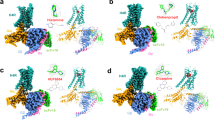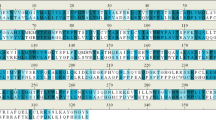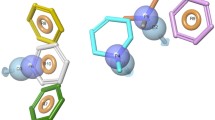Summary
The previously proposed models for the recognition and activation of 5-HT and histamine-H2 receptors, which were employed to explain the antagonist activity of LSD at both of these receptors, as well as the selective antagonism for H2 receptors by SKF-10856 and 9,10-dihydro-LSD, are used herein to design a compound to test the H2-receptor model. The design strategy attempts to construct a compound with potentially selective H2 agonism. The design scheme maintains features which were previously used to explain selective recognition of SKF-10856 and 9,10-dihydro-LSD as well as reintroduces the chemical features proposed to be responsible for H2 activation. The existence of the H2 recognition and activation features in the proposed compound is verified, in a previously proposed model, by computational studies of the molecular electrostatic potentials and shifts in the tautomeric preference.
Similar content being viewed by others
References
Weinstein H., Osman R., Topiol S. and Green J.P., Ann. N.Y. Acad. Sci., 367 (1981) 434.
Weinstein H., Osman R., Green J.P. and Topiol S., In Politzed P. and Truhlar D.G. (Eds.), Chemical Applications of Atomic and Molecular Electrostatic Potentials, Plenum, New York, 1981, pp. 309–334.
Osman R., Weinstein H., Topiol S. and Rubenstein L., Clin. Physiol. Biochem., 3 (1985) 80.
Osman R., Topiol S., Rubenstein L. and Weinstein H., Mol. Pharmacol., 32 (1987) 699.
Topiol S., Weinstein H. and Osman R., J. Med. Chem., 27 (1984) 1531.
Weinstein H., Mazurek A.P., Osman R. and Topiol S., Mol. Pharmacol., 29 (1986) 28.
Reggio P., Topiol S. and Weinstein H., J. Med. Chem., 29 (1986) 2412.
Reggio P., Weinstein H., Osman R. and Topiol S., Int. J. Quantum Chem. Quant. Biol. Symp., 8 (1981) 373.
Cambridge Crystallographic Data Centre, University Chemical Lab., Lensfield Road, Cambridge CB2 IEW, U.K.
Data Base version 1, entry LSDIBZ
Baker R.W., Chothia C., Pauling P. and Weber H.P., Science, 178 (1972) 614.
BioDesign Inc., 199 South Los Robles Avenue, Suite 270, Pasadena, CA 91101, U.S.A.
Mayo, S.L., Olafson, B. and Goddard, W.A., III, Submitted for publication.
Hehre W.J., Stewart R.F. and Pople J.A., J. Chem. Phys., 51 (1969) 2657.
Frisch M.J., Binkley J.S., Schlegel H.B., Raghavachari K., Melius C.F., Martin R.L., Stewart J.J.P., Bobrowicz F.W., Rohlfing C.M., Kahn L.R., DeFrees D.J., Seeger R., Whiteside R.A., Fox D.J., Fleuder E.M. and Pople J.A., GAUSSIAN 86, Carnegie-Mellon Quantum Chemistry Publishing Unit, Pittsburgh, PA, U.S.A., 1984.
Dewar M.J., Zoebisch E.G., Healy E.F. and Stewart J.J., J. Am. Chem. Soc., 107 (1985) 3902.
Stewart, J.J.P., AMPAC, version 1.00, Quantum Chemistry Program Exchange, Program Number 506, 1986.
Strader C.D., Candelore M.R., Hill W.S., Dixon R.A.F. and Sigal I.S., J. Biol. Chem., 264 (1989) 16470.
Shinitzky M. and Katchalski E., In Pullman E.B. (Ed.), Molecular Associations in Biology, Academic Press, New York, 1968, pp. 361–376.
Weinstein H., Chou D., Johnson C.L., Kang S. and Green J.P., Mol. Pharmacol., 128 (1976) 738.
Topiol S., Trends Biochem. Sci., 12 (1987) 419.
Weinstein H., Osman R. and Mazurek A.P., In Naray-Szabo G. and Simon K. (Eds.), Steric Aspects of Biomolecular Interactions, CRC Press, Inc., Boca Raton, FL 33431, U.S.A., 1987, pp. 119–210.
Topiol S., J. Comp. Chem., 8 (1987) 142.
Author information
Authors and Affiliations
Additional information
The majority of the work was conducted in the Department of Medicinal Chemistry, Berlex Laboratories, Inc., Cedar Knolls, NJ 07927, U.S.A.
Rights and permissions
About this article
Cite this article
Topiol, S., Sabio, M. The computational design of test compounds with potentially specific biological activity: Histamine-H2 agonists derived from 5-HT/H2 antagonists. J Computer-Aided Mol Des 5, 263–272 (1991). https://doi.org/10.1007/BF00124342
Received:
Accepted:
Issue Date:
DOI: https://doi.org/10.1007/BF00124342




